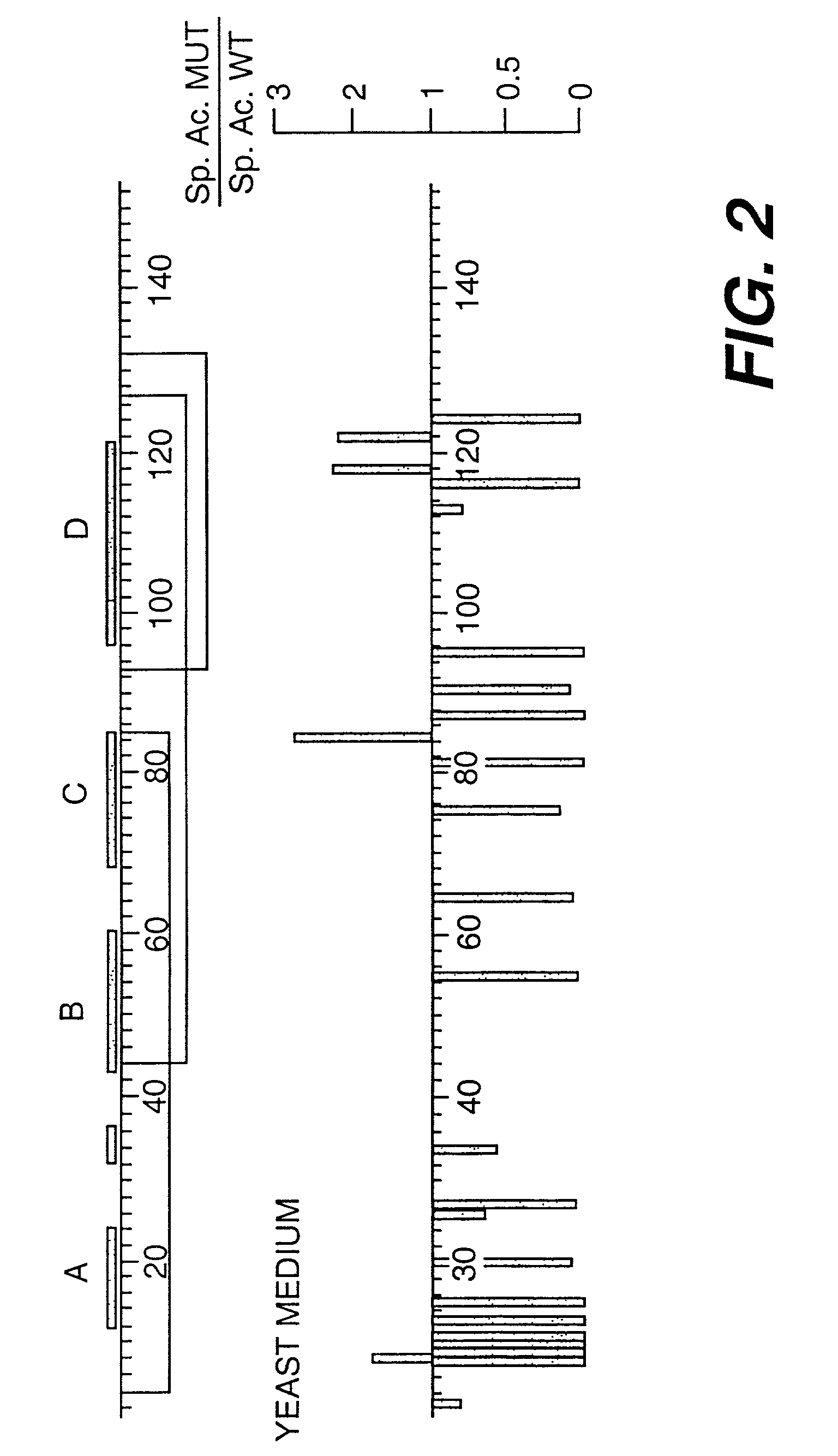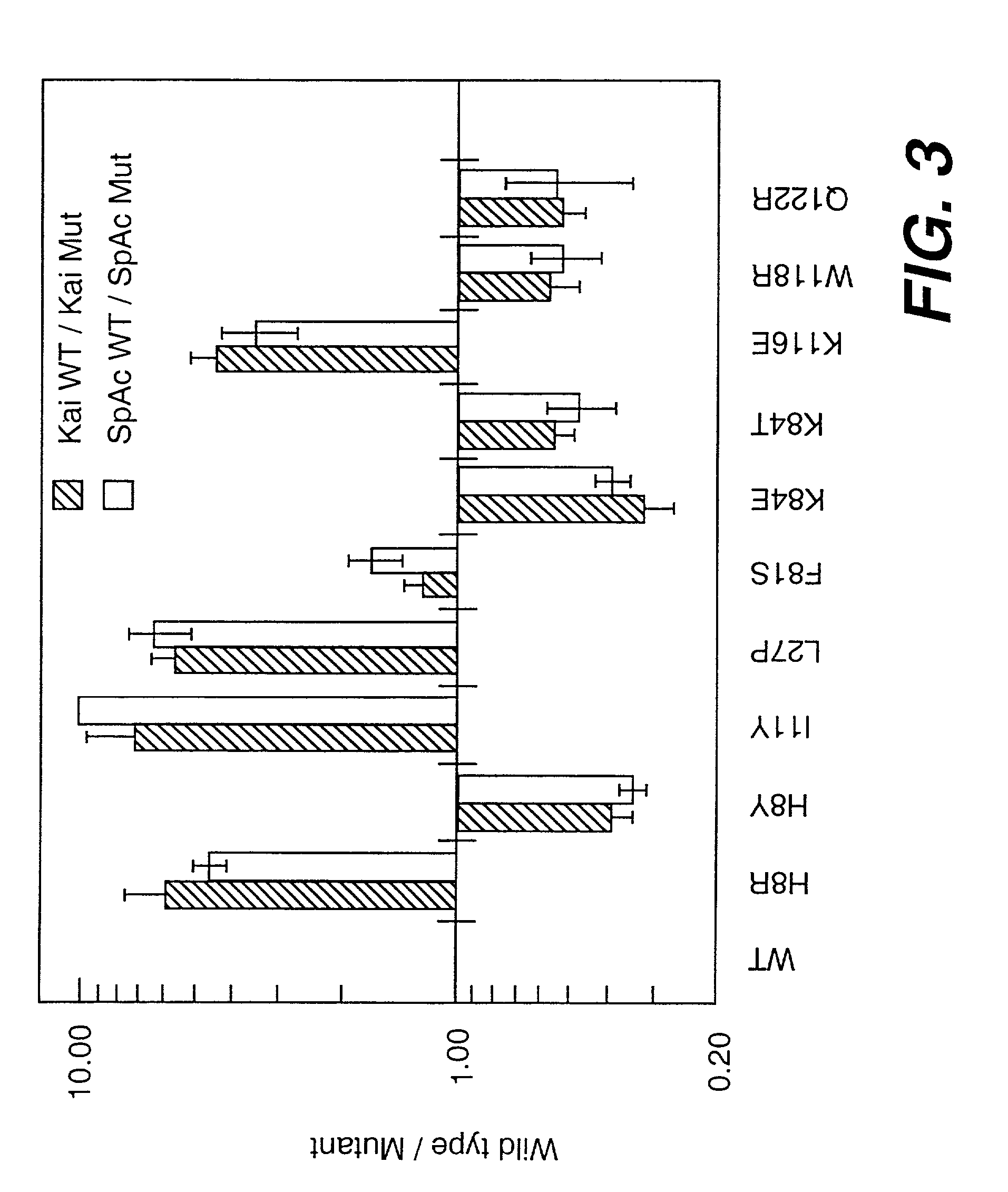Methods of using mutant flt3-ligand polypeptides to induce cellular expansion
a polypeptide and mutant technology, applied in the field of mutant polypeptides, can solve the problems of not well defined, regions of interest in the protein, and the conserved primary sequence of three growth factors, and achieve the effect of enhancing, enhancing or potentiating the immune response of the hos
- Summary
- Abstract
- Description
- Claims
- Application Information
AI Technical Summary
Benefits of technology
Problems solved by technology
Method used
Image
Examples
example 1
Generation of and Screening for flt3-L Mutants
[0140]The screening assay in which flt3-L mutants were identified utilized a flt3-L expression vector, which was subjected to random mutagenesis. Yeast were transformed using the mutagenized vectors, and subjected to a filter binding assay to detect secreted proteins. Proteins corresponding to flt3-L mutants were detected by reaction with an anti-flt3-L antibody, followed by a flt3-Fc fusion protein, and HRP-goat anti-human IgG, Fcy conjugate, as described below.
[0141]Construction of a Flt3-L Expression Vector
[0142]The flt3-L expression vector was constructed by inserting human flt3-L nucleic acid into the multicopy expression vector, paADH2. The sequence of a wild type flt3-L cDNA is disclosed in U.S. Pat. No. 5,554,512, and is set forth herein as SEQ ID NO:2. The paADH2 plasmid contains the 2μ origin of replication and the ADH2 promoter to drive expression of foreign genes, and the α-factor to direct secretion of heterologous proteins....
example 2
Characterization of Flt3-L Mutant Polypeptides
[0152]Identification of Flt3-L Mutant Polypeptides
[0153]The receptor-binding properties of the secreted flt3-L mutants were assessed visually by noting the variation from wild type flt3-L in intensity of the stained spots after the enzyme-linked reaction. Most colonies secreted flt3-L which stained similarly to wild type. About 1% of the colonies, however, gave rise to colonies devoid of stain. These clear white colonies were designated as receptor-binding deficient (flt3-L-), and were isolated by reference to their positions on the cellulose acetate membrane. The appearance of stained spots whose intensity was greater than that of wild type was a far more rare event. These dark colonies were isolated and designated flt3-L++, to indicate increased receptor binding properties over wild type. Approximately 60,000 colonies were screened, with up to 300 colonies assayed per standard size petri dish (82 mm diameter). All of the detectable flt...
example 3
Purification and Analysis of Flt3-L Mutant Polypeptides
[0173]Flt3-L mutants exhibiting greater than wild type specific activity in the WWF7 assay, as shown in Table 1 (e.g., H8Y (SEQ ID NO:11), K84E (SEQ ID NO:14), K84T (SEQ ID NO:15), W118R (SEQ ID NO:16), and Q122R (SEQ ID NO:17) ), were purified. Mutants with specific activities lower than wild type (e.g., H8R, I11Y, F81S, K116E) were selected for further study based on the relative proximity of their substitutions to mutations resulting in a flt3-L++ phenotype, and near wild type levels of expression. The L27P (SEQ ID NO:13) mutant, which is predicted to disrupt the dimerization interface of flt3-L, was also purified.
[0174]Preparation of Recombinant Human Flt3-L
[0175]Wild type and mutant flt3-L proteins were purified to greater than 90% homogeneity, according to the following protocol. Yeast medium (1.2 L) was filtered through a 0.22 μm membrane. The pH of the medium was adjusted to 4.0 by the addition of glacial acetic acid wit...
PUM
| Property | Measurement | Unit |
|---|---|---|
| diameter | aaaaa | aaaaa |
| pH | aaaaa | aaaaa |
| diameter | aaaaa | aaaaa |
Abstract
Description
Claims
Application Information
 Login to View More
Login to View More - R&D
- Intellectual Property
- Life Sciences
- Materials
- Tech Scout
- Unparalleled Data Quality
- Higher Quality Content
- 60% Fewer Hallucinations
Browse by: Latest US Patents, China's latest patents, Technical Efficacy Thesaurus, Application Domain, Technology Topic, Popular Technical Reports.
© 2025 PatSnap. All rights reserved.Legal|Privacy policy|Modern Slavery Act Transparency Statement|Sitemap|About US| Contact US: help@patsnap.com



